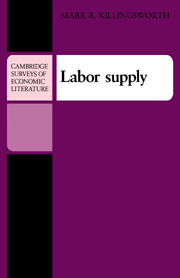Book contents
- Frontmatter
- Contents
- List of tables and figures
- Preface
- 1 The simple static model of labor supply
- 2 Extensions of the simple short-run model of labor supply
- 3 Empirical studies of static labor supply models: introduction, with a summary of “first-generation” results
- 4 Second-generation studies of static labor supply models: methodology and empirical results
- 5 Dynamic labor supply models
- 6 Labor supply, taxes, and transfers
- 7 Conclusion
- Bibliography
- Name index
- Subject index
2 - Extensions of the simple short-run model of labor supply
Published online by Cambridge University Press: 08 October 2009
- Frontmatter
- Contents
- List of tables and figures
- Preface
- 1 The simple static model of labor supply
- 2 Extensions of the simple short-run model of labor supply
- 3 Empirical studies of static labor supply models: introduction, with a summary of “first-generation” results
- 4 Second-generation studies of static labor supply models: methodology and empirical results
- 5 Dynamic labor supply models
- 6 Labor supply, taxes, and transfers
- 7 Conclusion
- Bibliography
- Name index
- Subject index
Summary
In this chapter, I consider four important reformulations of the simple model discussed in Chapter 1. Each reformulation modifies that model by introducing new assumptions about the nature of the utility function or about the constraints subject to which the individual maximizes utility.
Labor supply of family members
At one time or another, three main kinds of models of the relation between family membership and labor supply have attracted attention in the literature. In order of chronological appearance, the first of these, which might be called the male chauvinist model, is the simplest. In this analysis, the wife views her husband's earnings as a kind of property income (and so, in effect, regards her husband as a kind of income-producing asset) when she makes labor supply decisions, whereas the husband decides on his labor supply without reference to his wife's labor supply decisions, solely on the basis of his own wage and the family's actual property income. The male chauvinist model therefore differs from the simple model of Chapter 1 only with respect to its treatment of the labor supply of wives, and then only because the V relevant to the wife is assumed to include the husband's earned income as well as property income as such.
The second model to appear in the literature might be called the family utility–family budget constraint model.
- Type
- Chapter
- Information
- Labor Supply , pp. 29 - 66Publisher: Cambridge University PressPrint publication year: 1983

